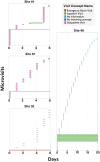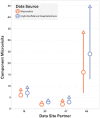Clinical encounter heterogeneity and methods for resolving in networked EHR data: a study from N3C and RECOVER programs
- PMID: 37087110
- PMCID: PMC10198518
- DOI: 10.1093/jamia/ocad057
Clinical encounter heterogeneity and methods for resolving in networked EHR data: a study from N3C and RECOVER programs
Abstract
Objective: Clinical encounter data are heterogeneous and vary greatly from institution to institution. These problems of variance affect interpretability and usability of clinical encounter data for analysis. These problems are magnified when multisite electronic health record (EHR) data are networked together. This article presents a novel, generalizable method for resolving encounter heterogeneity for analysis by combining related atomic encounters into composite "macrovisits."
Materials and methods: Encounters were composed of data from 75 partner sites harmonized to a common data model as part of the NIH Researching COVID to Enhance Recovery Initiative, a project of the National Covid Cohort Collaborative. Summary statistics were computed for overall and site-level data to assess issues and identify modifications. Two algorithms were developed to refine atomic encounters into cleaner, analyzable longitudinal clinical visits.
Results: Atomic inpatient encounters data were found to be widely disparate between sites in terms of length-of-stay (LOS) and numbers of OMOP CDM measurements per encounter. After aggregating encounters to macrovisits, LOS and measurement variance decreased. A subsequent algorithm to identify hospitalized macrovisits further reduced data variability.
Discussion: Encounters are a complex and heterogeneous component of EHR data and native data issues are not addressed by existing methods. These types of complex and poorly studied issues contribute to the difficulty of deriving value from EHR data, and these types of foundational, large-scale explorations, and developments are necessary to realize the full potential of modern real-world data.
Conclusion: This article presents method developments to manipulate and resolve EHR encounter data issues in a generalizable way as a foundation for future research and analysis.
Keywords: database; electronic health records; informatics.
© The Author(s) 2023. Published by Oxford University Press on behalf of the American Medical Informatics Association. All rights reserved. For permissions, please email: journals.permissions@oup.com.
Conflict of interest statement
None declared.
Figures






Similar articles
-
Data quality considerations for evaluating COVID-19 treatments using real world data: learnings from the National COVID Cohort Collaborative (N3C).BMC Med Res Methodol. 2023 Feb 17;23(1):46. doi: 10.1186/s12874-023-01839-2. BMC Med Res Methodol. 2023. PMID: 36800930 Free PMC article.
-
Harmonizing units and values of quantitative data elements in a very large nationally pooled electronic health record (EHR) dataset.J Am Med Inform Assoc. 2022 Jun 14;29(7):1172-1182. doi: 10.1093/jamia/ocac054. J Am Med Inform Assoc. 2022. PMID: 35435957 Free PMC article.
-
Temporal Events Detector for Pregnancy Care (TED-PC): A rule-based algorithm to infer gestational age and delivery date from electronic health records of pregnant women with and without COVID-19.PLoS One. 2022 Oct 31;17(10):e0276923. doi: 10.1371/journal.pone.0276923. eCollection 2022. PLoS One. 2022. PMID: 36315520 Free PMC article.
-
Documentation and review of social determinants of health data in the EHR: measures and associated insights.J Am Med Inform Assoc. 2021 Nov 25;28(12):2608-2616. doi: 10.1093/jamia/ocab194. J Am Med Inform Assoc. 2021. PMID: 34549294 Free PMC article. Review.
-
From real-world electronic health record data to real-world results using artificial intelligence.Ann Rheum Dis. 2023 Mar;82(3):306-311. doi: 10.1136/ard-2022-222626. Epub 2022 Sep 23. Ann Rheum Dis. 2023. PMID: 36150748 Free PMC article. Review.
Cited by
-
Unveiling sub-populations in critical care settings: a real-world data approach in COVID-19.Front Public Health. 2025 May 15;13:1544904. doi: 10.3389/fpubh.2025.1544904. eCollection 2025. Front Public Health. 2025. PMID: 40443932 Free PMC article.
-
MENDS-on-FHIR: leveraging the OMOP common data model and FHIR standards for national chronic disease surveillance.JAMIA Open. 2024 May 29;7(2):ooae045. doi: 10.1093/jamiaopen/ooae045. eCollection 2024 Jul. JAMIA Open. 2024. PMID: 38818114 Free PMC article.
-
Critical Data for Critical Care: A Primer on Leveraging Electronic Health Record Data for Research From Society of Critical Care Medicine's Panel on Data Sharing and Harmonization.Crit Care Explor. 2024 Nov 15;6(11):e1179. doi: 10.1097/CCE.0000000000001179. eCollection 2024 Nov. Crit Care Explor. 2024. PMID: 39559555 Free PMC article. Review.
-
Data quality considerations for evaluating COVID-19 treatments using real world data: learnings from the National COVID Cohort Collaborative (N3C).BMC Med Res Methodol. 2023 Feb 17;23(1):46. doi: 10.1186/s12874-023-01839-2. BMC Med Res Methodol. 2023. PMID: 36800930 Free PMC article.
-
Opportunities and Challenges in Using Electronic Health Record Systems to Study Postacute Sequelae of SARS-CoV-2 Infection: Insights From the NIH RECOVER Initiative.J Med Internet Res. 2025 Mar 5;27:e59217. doi: 10.2196/59217. J Med Internet Res. 2025. PMID: 40053748 Free PMC article.
References
Publication types
MeSH terms
Grants and funding
- UM1 TR004404/TR/NCATS NIH HHS/United States
- UL1 TR001998/TR/NCATS NIH HHS/United States
- UL1 TR002535/TR/NCATS NIH HHS/United States
- UL1 TR002736/TR/NCATS NIH HHS/United States
- UL1 TR001878/TR/NCATS NIH HHS/United States
- UL1 TR002369/TR/NCATS NIH HHS/United States
- UL1 TR001433/TR/NCATS NIH HHS/United States
- UL1 TR002537/TR/NCATS NIH HHS/United States
- UL1 TR002014/TR/NCATS NIH HHS/United States
- UL1 TR001425/TR/NCATS NIH HHS/United States
- U54 GM104938/GM/NIGMS NIH HHS/United States
- UL1 TR002544/TR/NCATS NIH HHS/United States
- U54 GM115516/GM/NIGMS NIH HHS/United States
- UL1 TR001453/TR/NCATS NIH HHS/United States
- UL1 TR002003/TR/NCATS NIH HHS/United States
- UL1 TR001876/TR/NCATS NIH HHS/United States
- UL1 TR002538/TR/NCATS NIH HHS/United States
- UL1 TR001881/TR/NCATS NIH HHS/United States
- U54 GM115677/GM/NIGMS NIH HHS/United States
- UL1 TR003107/TR/NCATS NIH HHS/United States
- UL1 TR001414/TR/NCATS NIH HHS/United States
- U54 GM115428/GM/NIGMS NIH HHS/United States
- UL1 TR003098/TR/NCATS NIH HHS/United States
- OT2HL161847/NH/NIH HHS/United States
- UL1 TR002001/TR/NCATS NIH HHS/United States
- UM1 TR004406/TR/NCATS NIH HHS/United States
- U54 GM115458/GM/NIGMS NIH HHS/United States
- UL1 TR002378/TR/NCATS NIH HHS/United States
- UL1 TR002494/TR/NCATS NIH HHS/United States
- UL1 TR002645/TR/NCATS NIH HHS/United States
- OT2 HL161847/HL/NHLBI NIH HHS/United States
- UL1 TR002649/TR/NCATS NIH HHS/United States
- U54 GM115371/GM/NIGMS NIH HHS/United States
- UL1 TR001420/TR/NCATS NIH HHS/United States
- U54 GM104940/GM/NIGMS NIH HHS/United States
- UL1 TR003017/TR/NCATS NIH HHS/United States
- UL1 TR001422/TR/NCATS NIH HHS/United States
- UL1 TR001442/TR/NCATS NIH HHS/United States
- UL1 TR001860/TR/NCATS NIH HHS/United States
- UL1 TR002366/TR/NCATS NIH HHS/United States
- UL1 TR002377/TR/NCATS NIH HHS/United States
- UL1 TR002733/TR/NCATS NIH HHS/United States
- UL1 TR002550/TR/NCATS NIH HHS/United States
- UL1 TR002553/TR/NCATS NIH HHS/United States
- UL1 TR002541/TR/NCATS NIH HHS/United States
- UL1 TR001439/TR/NCATS NIH HHS/United States
- UL1 TR003096/TR/NCATS NIH HHS/United States
- UL1 TR002529/TR/NCATS NIH HHS/United States
- UL1 TR002319/TR/NCATS NIH HHS/United States
- U54 GM104941/GM/NIGMS NIH HHS/United States
- U24 TR002306/TR/NCATS NIH HHS/United States
- UL1 TR002389/TR/NCATS NIH HHS/United States
- UL1 TR001436/TR/NCATS NIH HHS/United States
- UL1 TR001872/TR/NCATS NIH HHS/United States
- UL1 TR002384/TR/NCATS NIH HHS/United States
- UL1 TR002240/TR/NCATS NIH HHS/United States
- UL1 TR001445/TR/NCATS NIH HHS/United States
- UL1 TR003142/TR/NCATS NIH HHS/United States
- UL1 TR001412/TR/NCATS NIH HHS/United States
- UL1 TR002373/TR/NCATS NIH HHS/United States
- UL1 TR002345/TR/NCATS NIH HHS/United States
- UL1 TR001855/TR/NCATS NIH HHS/United States
- UL1 TR002556/TR/NCATS NIH HHS/United States
- UL1 TR001449/TR/NCATS NIH HHS/United States
- UL1 TR001409/TR/NCATS NIH HHS/United States
- UL1 TR001866/TR/NCATS NIH HHS/United States
- UL1 TR003015/TR/NCATS NIH HHS/United States
- UL1 TR001450/TR/NCATS NIH HHS/United States
- UL1 TR001873/TR/NCATS NIH HHS/United States
- U54 GM104942/GM/NIGMS NIH HHS/United States
- UL1 TR001427/TR/NCATS NIH HHS/United States
- UL1 TR003167/TR/NCATS NIH HHS/United States
- UL1 TR002243/TR/NCATS NIH HHS/United States
LinkOut - more resources
Full Text Sources
Medical
Miscellaneous

